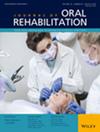Looking at Burning Mouth Syndrome Brain: The Prevalence of Idiopathic Intracranial Hypertension Radiologic Signs in BMS Patients
Abstract
Background
Idiopathic intracranial hypertension (IIH), a disorder characterised by an elevation of intracranial pressure, has implications in chronic pain syndromes, especially in the cranial territory, and has been a matter of discussion. This study explores an association between burning mouth syndrome (BMS) and cerebrospinal fluid dynamic disturbances, as in IIH, by analysing the prevalence of MRI signs of impaired intracranial pressure control in BMS patients.
Methods
This was a case–control with a cross-section design study carried out at the Oral Medicine Unit, Federico II University of Naples, between September 2022 and March 2023. The observer was blinded on MRI measurements. Patients were recruited sequentially in the BMS referral centre of the Oral Medicine Unit. Thirty-seven BMS patients and 37 healthy controls were consecutively enrolled during their first visit with an oral medicine specialist and a general dentist respectively. A non-contrast brain MRI including an MRI venography of the intracranial venous vessels and a fundus oculi in order to evaluate the presence of papilloedema (an ophthalmological sign of raised intracranial pressure) was performed on all participants. The radiologic diagnostic criteria of IIH to include the patient in the study were at least 3 out of 4 indirect signs on the neuroimaging (empty sella, enlargement of the optic nerve sheets, bulb flattening and dural sinus stenosis).
Results
Thirty-seven patients with BMS and 37 HCs were included in the study with a female predominance in the BMS group. The prevalence of enlargement of the optic nerve sheath diameter (6.0 vs. 5.3; p < 0.001), the prevalence of empty sella (54.1% vs. 13.5%; p < 0.001), and the prevalence of dural sinus stenosis/hypoplasia (97.3% vs. 27%; p < 0.001) were statistically significantly higher in the BMS group than in HCs.
Conclusions
The higher prevalence of IIH signs on neuroimaging (empty sella, enlargement of the optic nerve sheets and dural sinus stenosis) in BMS patients compared to HCs highlights that BMS should be considered a chronic neurological disorder. The investigation of CSF dynamics in BMS patients could reveal new perspectives on the diagnosis and pathogenesis of the disease.


 求助内容:
求助内容: 应助结果提醒方式:
应助结果提醒方式:


